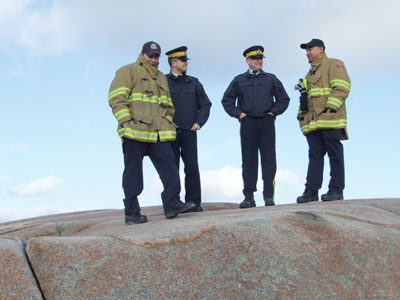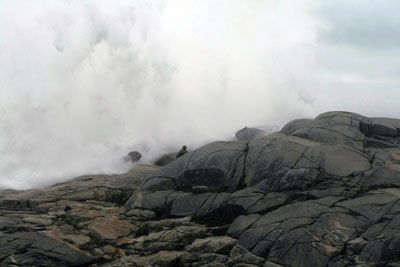
Features
Volunteers
Volunteer firefighters save Mountie in daring rescue
Peggy’s Cove, just outside Halifax, is one of the biggest tourist attractions in Nova Scotia. The picturesque village and its famous lighthouse draws an estimated 750,000 visitors a year. When that many people closely interact with an unpredictable Atlantic Ocean, some tragedy is inevitable.
January 5, 2011
By John Giggey
Peggy’s Cove, just outside Halifax, is one of the biggest tourist
attractions in Nova Scotia. The picturesque village and its famous
lighthouse draws an estimated 750,000 visitors a year. When that many
people closely interact with an unpredictable Atlantic Ocean, some
tragedy is inevitable.

|
| The two firefighters and two RCMP officers involved in the Nov. 6 rescue of Const. Chris Richard meet at Peggy’s Cove on Dec. 9 for the first time since the incident. From left are firefighter Jason Sparkes, constables Scott Locke and Richard, and firefighter Greg Kutney. At this time, Richard was still recovering from his injuries and had not yet returned to duty. Waves were washing over these rocks on the night of Nov. 6. (Photo by Halifax Fire and Emergency Services)
|
During a November storm, huge waves took the life of one man. Then, the
ocean almost claimed an RCMP constable and the three rescuers who went
to save him. Here is their story.

|
|
| This was not the first time members from Station 55 had performed a dramatic rescue in the face of fierce waves at Peggy’s Cove. Most of the volunteer firefighters in this photo can’t even be seen as a wave crashes ashore during Tropical Storm Noel on Nov. 2, 2007. They are immobilizing a man who strayed too close to the water. He was caught by a huge wave, lifted high in the air, and dropped about six metres to the rocks.(Photo by Wayne Joy) Advertisement
|
A few kilometres down the coastal highway from Peggy’s Cove is
Seabright, a village of just over 500 people. That’s where Station 55
of Halifax Regional Fire & Emergency Service is located. The
department has 58 fire stations, staffed by about 400 career and 800
volunteer firefighters. Station 55 is first due at emergencies in a
number of villages along that section of St. Margaret’s Bay, as well as
Peggy’s Cove.
The station is staffed by two career members, a lieutenant and a
firefighter, 10.5 hours a day, from 7 a.m. until 5:30 p.m. on weekdays.
The rest of the time it is entirely a volunteer operation. If something
goes wrong at Peggy’s Cove, Station 55 gets the page. The run is almost
20 minutes. And members have made that trip many times over the years.
It was around 6:20 p.m. on Nov. 6 that the tone came in for a man swept
off the rocks at Peggy’s Cove. It was a stormy night; dark, very high
winds, heavy rain.
None of the responders knew it yet, but by the time they arrived it
would already be too late for the victim, whose body would be recovered
more than a week later. But as events unfolded, two firefighters and an
RCMP officer would find themselves in that position none of us ever
wants to be in: to have to decide in an instant whether to attempt an
extremely high risk rescue with practically no safety gear and no
backup. That decision is made even more difficult when the person whose
life is at stake is a fellow first responder.
Volunteer firefighter Greg Kutney, a first-year medical student at the
Dalhousie Faculty of Medicine in Halifax, was driving Engine 55. Right
behind him was Rescue 55 with firefighter Jason Sparkes on board.
Rescue boats 56 (Black Point) and 58 (Lakeside) were also on the road.
They were about 20 minutes behind the Seabright units.
RCMP Const. Chris Richard, who has been on the force for about four
years, would arrive about the same time as the first-in trucks. Another
RCMP constable, Scott Locke, would be about five minutes behind.
“We were laying out a plan in the truck,” recalls Kutney. “Once we got
a better location on the victim we would radio the other units and tell
them where to launch. Then, when we passed the government wharf [at
Peggy’s Cove] and saw the waves, we knew we didn’t need any boats.
There was no way to launch anything in those waves.”
On arrival, the firefighters were directed to the parking lot behind
the Sou’Wester Restaurant. The waves were so high that water was
flowing down the land side of the huge rocks several hundred feet away.
While they were still on the road, Sou’Wester manager John Campbell had
taken the time to determine exactly where the victim was last seen.
Grabbing some throw bags and life vests, Sparkes and Kutney, along with
Const. Richard, headed toward the rocks, with Campbell guiding them.
Part way up, Kutney gave everybody life jackets. When they got to the
top of the rocks, Campbell, who knew this water better than anyone else
there, took one look at the waves and told them to stop.
Const. Richard didn’t hear him and continued on for a few feet. The
others lost sight of Richard in the darkness and presumed he was
checking along the ridge. Their focus was on the man who had been
washed away.
Sparkes, a master seaman in the navy, used his spotlight to probe the
ocean for any sign of the missing man. But what they saw in the water
shocked them all. Reflecting back was the life jacket they had just
given Const. Richard. A wave had taken him out and he was already 100
feet away.
“He was too far out,” says Sparkes. “We tried to use throw bags but it didn’t work. There was nothing we could do.”
But just then a large wave picked up the officer and threw him onto the
rocks. When it receded, Richard was sprawled and injured on rocks some
distance away and near the water. “I knew this was the one chance,”
says Sparkes. “I figured if we don’t go for him now, he’s gone.”
The Atlantic Ocean was not going to wait while a crew was formed and
outfitted, a plan formulated, a backup team put in place, and safety
lines laid.
Since he was the closest, Sparkes raced to the Mountie. His plan was to
lift Richard over a ledge to a higher boulder, then drag him to safer
ground. But the officer was dead weight and Sparkes couldn’t lift him.
With another eight-metre wave about to crash down on top of them,
Sparkes opted to stay with Richard. Sparkes used his body to pin the
officer to the rocks, found a handhold, took a deep breath and hung on.
The wave hammered them. He managed to keep his grip as the water
receded. By then Kutney and Const. Locke, who had just arrived and
didn’t even have a life jacket, were beside him. Together they got the
injured officer over the ledge and started the long drag to the top of
the rocks.
The fight with the ocean wasn’t over yet. Time and again the crew was
knocked down by huge walls of water. Together they would shelter
Richard as best they could and hang on to each other, trying not to be
washed away. Then they would gain a few more feet up the slope between
waves.
Other firefighters from Station 55 came over the top of the hill with a
backboard and, thinking they were finally on high enough ground, the
group tried to immobilize Richard, who was in severe pain. But another
wave washed over them. They struggled higher up the slope and tried
again, but were again hit by waves.
Finally they got clear of the water. They secured Richard to the
backboard, and made the long, treacherous walk back down the rock face
on the land side to the parking lot, where paramedics were waiting.
Const. Locke, firefighters Sparkes and Kutney, and several other
members of the Station 55 crew, sustained bumps and bruises from being
thrown around on the rocks but were otherwise all right.
There was one factor that worked in favour of the rescuers. While the
waves hitting them were huge, they weren’t as big as the monster that
took the policeman off the rocks in the first place.
“Normally they come in a series of low waves, then larger ones,” says
Kutney. “We were lucky that when we got to him there was a series of
smaller waves before the larger ones started again.”
Richard was treated by paramedics on the scene and then transported to
hospital. He was later released but had not been able to return to work
when this issue of Canadian Firefighter and EMS Quarterly went to press
in December.
Station 55 volunteer Chief Kevin Smith, who joined the old Seabright
Volunteer Fire Department about 24 years ago, has been on calls to
Peggy’s Cove many times.
“Generally it’s a medical call or someone falls on the rocks,” he says.
“But usually when you get swept off the rocks, you don’t come back.”
This rescue was the third water-related rescue call to Peggy’s Cove in 2010. Some years there aren’t any.
On Dec. 9, firefighters Sparkes and Kutney, and constables Locke and
Richard, met at Peggy’s Cove for the first time since the storm. The
four walked and climbed part way down the rocks and stood quietly as
they looked at the spot, another nine metres below, where Richard had
been thrown. Having been there that night myself and having seen the
waves, it was hard to imagine how any of them had survived.
Even as Sparkes was making his way down to him, Richard was hit by
several waves. If Sparkes had even been just a few more seconds getting
to his side, there may not have been a rescue to make.
“I didn’t have anything left,” Richard says. “I knew the next wave would finish me.”
John Giggey is a retired volunteer captain
with Halifax Regional Fire and Emergency Service and a former senior
editor with The Canadian Press. He now works with HRFE in public
affairs and publishes the department’s in-house magazine, FeedLine.
Print this page